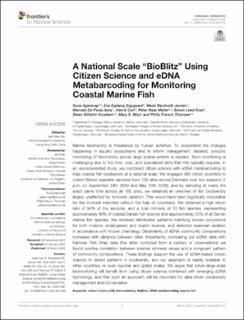| dc.contributor.author | Agersnap, Sune | |
| dc.contributor.author | Sigsgaard, Eva Egelyng | |
| dc.contributor.author | Jensen, Mads Reinholdt | |
| dc.contributor.author | Ávila, Marcelo De Paula | |
| dc.contributor.author | Carl, Henrik | |
| dc.contributor.author | Møller, Peter Rask | |
| dc.contributor.author | Krøs, Simon Leed | |
| dc.contributor.author | Knudsen, Steen Wilhelm | |
| dc.contributor.author | Wisz, Mary S. | |
| dc.contributor.author | Thomsen, Philip Francis | |
| dc.date.accessioned | 2022-07-12T09:37:30Z | |
| dc.date.available | 2022-07-12T09:37:30Z | |
| dc.date.created | 2022-03-30T10:36:06Z | |
| dc.date.issued | 2022 | |
| dc.identifier.citation | Frontiers in Marine Science. 2022, 9, 824100. | en_US |
| dc.identifier.issn | 2296-7745 | |
| dc.identifier.uri | https://hdl.handle.net/11250/3004634 | |
| dc.description.abstract | Marine biodiversity is threatened by human activities. To understand the changes happening in aquatic ecosystems and to inform management, detailed, synoptic monitoring of biodiversity across large spatial extents is needed. Such monitoring is challenging due to the time, cost, and specialized skills that this typically requires. In an unprecedented study, we combined citizen science with eDNA metabarcoding to map coastal fish biodiversity at a national scale. We engaged 360 citizen scientists to collect filtered seawater samples from 100 sites across Denmark over two seasons (1 p.m. on September 29th 2019 and May 10th 2020), and by sampling at nearly the exact same time across all 100 sites, we obtained an overview of fish biodiversity largely unaffected by temporal variation. This would have been logistically impossible for the involved scientists without the help of volunteers. We obtained a high return rate of 94% of the samples, and a total richness of 52 fish species, representing approximately 80% of coastal Danish fish species and approximately 25% of all Danish marine fish species. We retrieved distribution patterns matching known occurrence for both invasive, endangered, and cryptic species, and detected seasonal variation in accordance with known phenology. Dissimilarity of eDNA community compositions increased with distance between sites. Importantly, comparing our eDNA data with National Fish Atlas data (the latter compiled from a century of observations) we found positive correlation between species richness values and a congruent pattern of community compositions. These findings support the use of eDNA-based citizen science to detect patterns in biodiversity, and our approach is readily scalable to other countries, or even regional and global scales. We argue that future large-scale biomonitoring will benefit from using citizen science combined with emerging eDNA technology, and that such an approach will be important for data-driven biodiversity management and conservation. | en_US |
| dc.language.iso | eng | en_US |
| dc.publisher | Frontiers | en_US |
| dc.rights | Navngivelse 4.0 Internasjonal | * |
| dc.rights.uri | http://creativecommons.org/licenses/by/4.0/deed.no | * |
| dc.title | A National Scale “BioBlitz” Using Citizen Science and eDNA Metabarcoding for Monitoring Coastal Marine Fish | en_US |
| dc.type | Peer reviewed | en_US |
| dc.type | Journal article | en_US |
| dc.description.version | publishedVersion | en_US |
| dc.rights.holder | Copyright © 2022 Agersnap, Sigsgaard, Jensen, Avila, Carl, Møller, Krøs, Knudsen, Wisz and Thomsen. | en_US |
| dc.source.pagenumber | 17 | en_US |
| dc.source.volume | 9 | en_US |
| dc.source.journal | Frontiers in Marine Science | en_US |
| dc.identifier.doi | 10.3389/fmars.2022.824100 | |
| dc.identifier.cristin | 2013613 | |
| cristin.ispublished | true | |
| cristin.fulltext | original | |
| cristin.qualitycode | 1 | |

